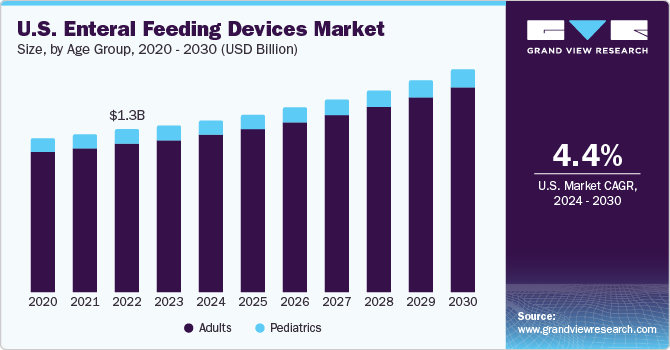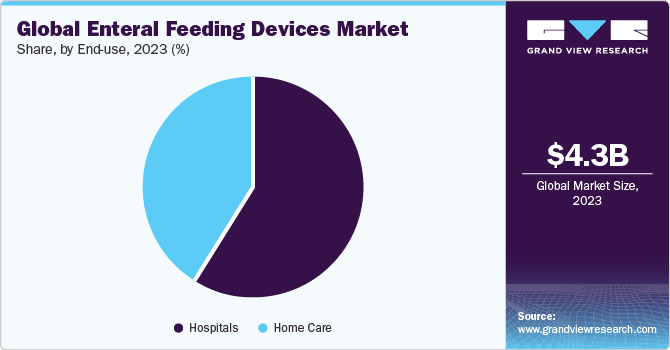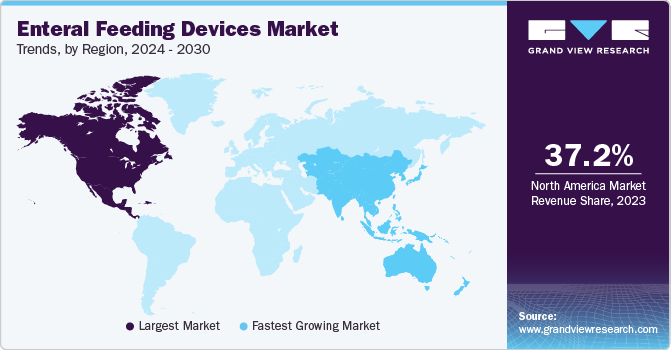- Home
- »
- Medical Devices
- »
-
Enteral Feeding Devices Market Size & Share Report, 2030GVR Report cover
![Enteral Feeding Devices Market Size, Share & Trends Report]()
Enteral Feeding Devices Market Size, Share & Trends Analysis Report By Product (Giving Set, Enteral Feeding Pump), By Age Group (Adults, Pediatrics), By Indication (Alzheimer’s, Nutrition Deficiency), By End-use, By Region, And Segment Forecasts, 2024 - 2030
- Report ID: 978-1-68038-009-5
- Number of Report Pages: 172
- Format: PDF, Horizon Databook
- Historical Range: 2018 - 2022
- Forecast Period: 2024 - 2030
- Industry: Healthcare
Enteral Feeding Devices Market Trends
The global enteral feeding devices market size was valued at USD 4.3 billion in 2023 and is projected to grow at a compound annual growth rate (CAGR) of 5.0% from 2024 to 2030. Growing geriatric population has resulted in increased incidences of diabetes, severe pancreatitis, and other gastrointestinal diseases, which aids market growth. Adoption of the “Feed Early Enteral Diet Adequately for Maximum Effect” (FEED ME) protocol in surgical trauma ICUs in the U.S. enables subsidies on these devices. Technological advancements such as the introduction of tri-funnel replacement G-tubes and J-tubes with reverse balloon designs are also expected to aid in growth during the forecast period.

Numerous NCBI studies suggest that people over 65 years pose a higher risk of developing chronic illnesses including Parkinson’s and nervous system disorders. The global population aged 60 years and older is expected to increase from around 1 billion in 2020 to about 1.4 billion in 2030 and is expected to double by 2050 to reach around 2.1 billion. The number of elderly patients with critical illnesses has increased significantly over the past few years. The risk of malnutrition and frailty among the geriatric population with comorbidities, such as stroke, depression, and dementia, is much higher, mainly owing to various age-related changes in body composition and muscle mass. This results in a reduced ability to perform Activities of Daily Living (ADLs), thereby increasing the risk of falls or injuries.
Market Dynamics
Rising prevalence of chronic disease is one of the major factors driving the demand for enteral feeding devices. There has been a constant increase in the prevalence of chronic diseases, such as Alzheimer’s disease, Attention Deficit Hyperactivity Disorder (ADHD), osteoporosis, osteoarthritis, central nervous system disorders, and other diseases, which require clinical dietary management. These devices are highly adopted by geriatric population who are dealing with chronic conditions for proper intake of nourishment and, thus, fueling the market growth.
According to a report by CDC, about 6 in 10 adults are suffering from at least one chronic condition. Thus, growing number of surgeries throughout the world also boosts market growth as these devices are commonly used for providing nutrition to critical care patients. According to an article by NCBI, on an average, 310 million surgeries are performed every year globally, providing growth opportunities for the market. Increasing healthcare expenditure, growing healthcare infrastructure, and advancements in medical devices further can fuel the market over the forecast period.
Restraint
General lack of awareness and understanding regarding enteral nutrition in the medical community is projected to limit its adoption. It requires prescription and supervision by medical professionals. Although these products are gaining acceptance, they remain poorly understood by patients, physicians, and pharmacists. This factor prevents doctors from adopting or prescribing enteral nutrition, which may restrain market growth. Not all medical experts are convinced that enteral formula would be successful in the treatment of chronic conditions and their symptoms, which may negatively impact the adoption of enteral feeding products along with treatment.
Product Insights
Based on products, the enteral feeding pump segment dominated the market in 2023 with a 50.8% share as these pumps are designed for safer & more intuitive nutritional care. Enteral feeding is the process of delivering nutrients directly to the stomach through a tube, and the tube is connected to an electric pump. Growing healthcare infrastructure and technological advancements in medical devices segment are expected to drive market growth. Technological advancements such as introduction of compact, reliable, and easy-to-use devices, such as Kangaroo ePump developed by Covidien, are expected to boost the demand for enteral feeding pumps during the forecast period.
The low-profile gastrostomy device is anticipated to expand at a significant pace with a CAGR of 5.4%. It is introduced as an alternative to traditional gastrostomy tubes. Passport low-profile gastrostomy devices by Cook Medical and MIC-KEY by Kimberly-Clark are very popular and highly prescribed feeding tubes, which are easy to conceal and ideal for all individuals.
Age Group Insights
The adult age group segment dominated the market with a revenue share of 91.3% in 2023. A published paper in NCBI stated that approximately 70-80% of pregnant women suffer from nausea and vomiting during pregnancy. In such cases, enteral nutrition is used to prevent adverse conditions, including fetal intrauterine growth restriction, preterm infant birth incidents, and maternal dehydration.

Enteral feeding involves administration of liquid nutrients through a tube directly into the gastrointestinal tract. In addition, according to the WHO, approximately 45% of deaths in children aged 5 years are associated with undernutrition. According to a report published by the UNICEF, approximately 3 million young individuals die every year due to malnutrition. Some types of enteral feeding formulas used for infants are nasojejunal, nasoduodenal, and gastrostomy, as well as jejunostomy tubes.
Indication Insights
Based on indication, the cancer care segment dominated the market with a revenue share of 27.9% in 2023. Enteral feeding can be used in critically ill patients for many other diseases and conditions, such as COPD, cystic fibrosis, and respiratory disorders. For instance, Pulmocare, an Abbott product, is used as an enteral feed for treatment of these conditions. Conditions such as inflammation, postoperative stress, and infections can also be treated with the help of enteral feeds.
Orphan diseases is projected to increase at the fastest CAGR over the forthcoming years. According to the Ministry of Health and Family Welfare (MoHFW), Government of India, approximately 300 million individuals globally are living with rare diseases, and around 72% of these diseases are genetic and approximately 70% of these rare genetic diseases begin in childhood. Thus, due to an increase in awareness about enteral nutrition and a rise in number of diseases categorized as orphan diseases, the market is expected to grow at the fastest rate over the forecast period.
End-use Insights
Based on end-use, hospitals dominated the market with a 58.3% market share in 2023. Growing awareness among healthcare professionals and others regarding hospital-associated malnutrition is one of the significant factors expected to boost the use and demand for enteral feeding devices in hospitals. Moreover, increasing number of ICU admissions & re-admissions, increasing demand for enteral foods & formulations among critically or severely ill patients, and rising prevalence of several chronic disorders such as diabetes, cancer, & others are some of the major factors that drive the market growth.
The home care segment is projected to increase at the fastest CAGR over the forthcoming years. According to the Oley Foundation, it is estimated that more than 344,000 individuals of all ages in the U.S. are taking home enteral nutrition. Moreover, according to the British Artificial Nutrition Survey (BANS), more than 59% require support for home enteral tube feeding in the UK. Therefore, due to increase in the number of alternative care options and rapid technological advancements, the market is anticipated to grow at a significant rate during the forecast period.
Regional Insights
North America held the largest market share of 37.2% in 2023. Growing number of premature infants in critical care is a major factor driving the regional market growth. For instance, according to CDC, about 1 in 10 babies was born prematurely in the U.S. in 2021. The market is significantly driven by increase in geriatric population, which is more susceptible to chronic diseases that result in various disorders such as gastrointestinal disorders, metabolic disorders, and neurological disorders.

Asia Pacific is anticipated to register the fastest growth over the forthcoming years. The region has a large patient pool and geriatric population. Lifestyle changes are leading to an increase in prevalence of various diseases such as cancer, diabetes, gastrointestinal disorders, and autoimmune diseases. This is ultimately expected to increase the demand for enteral feeding devices for the dietary management of chronic diseases. Japan and China have a large elderly population, which is at a high risk of chronic conditions. Nutritional deficiencies are more common in geriatric population, and it is expected to boost the demand for enteral feeding devices in Asia Pacific. According to World Hunger Education Service, around 70% of all malnourished children live in Asia.
Key Companies & Market Share Insights
The market players are focusing on product development, new technological advancements, and other initiatives to strengthen their market position.
Key Enteral Feeding Devices Companies:
- Conmed Corporation
- C.R.Bard
- Cook Medical
- Boston Scientific Corporation
- Moog Inc.
- Fresenius Kabi AG
- Danone Medical Nutrition
- Kimberly-Clark
- Abbott Nutrition
- B Braun Melsungen AG
- Avanos Medical, Inc.
- Cardinal Health
- Applied Medical Technology, Inc.
- Vygon India
- Fidmi Medical
- ALCOR Scientific
- Amsino International, Inc.
Recent Developments
-
In September 2023, Cardinal Health launched Kangaroo OMNI enteral feeding pump, intended to give patients undergoing enteral feeding more options to suit their individual needs over the course of their enteral feeding journey.
-
In August 2023, Cardinal Health launched its next-generation NTrainerTM System 2.0, a medical device intended to shorten the length of stay in the neonatal intensive care unit (NICU) for premature and newborn infants by assisting them in developing the oral coordination skills necessary for the transition to independent feeding more quickly. The NTrainerTM System gives parents confidence in their newborns' progress and potential for success after discharge by giving clinicians the objective data they need to monitor an infant's development of pre-feeding skills through real-time assessment technology.
Enteral Feeding Devices Market Report Scope
Report Attribute
Details
Market size value in 2024
USD 4.4 billion
Revenue forecast in 2030
USD 5.9 billion
Growth rate
CAGR of 5.0% from 2024 to 2030
Base year for estimation
2023
Historical data
2018 - 2022
Forecast period
2024 - 2030
Report updated
November 2023
Quantitative units
Revenue in USD million/billion and CAGR from 2024 to 2030
Report coverage
Revenue forecast, company share, competitive landscape, growth factors, trends
Segment Covered
Product, age group, indication, end-use, region
Regional scope
North America; Europe; Asia Pacific; Latin America; Middle East & Africa
Country scope
U.S.; Canada; U.K.; Germany; France; Spain; Italy; Sweden; Norway; Denmark; Russia; Japan; China; India; South Korea; Australia; Thailand; Singapore; Brazil; Mexico; Argentina; South Africa; UAE; Saudi Arabia; Kuwait
Key companies profiled
Conmed Corporation; C.R.Bard; Cook Medical; Boston Scientific Corporation; Moog Inc.; Fresenius Kabi AG; Danone Medical Nutrition; Kimberly-Clark; Abbott Nutrition; B Braun Melsungen AG; Avanos Medical, Inc.; Cardinal Health; Applied Medical Technology, Inc.; Vygon India; Fidmi Medical; ALCOR Scientific; Amsino International, Inc.
Customization scope
Free report customization (equivalent to up to 8 analysts' working days) with purchase. Addition or alteration to country, regional & segment scope.
Pricing and purchase options
Avail of customized purchase options to meet your exact research needs. Explore purchase options
Global Enteral Feeding Devices Market Report Segmentation
This report forecasts revenue growth at global, regional, & country levels and provides an analysis of the latest industry trends in each of the segments from 2018 to 2030. For this study, Grand View Research, Inc. has segmented the global enteral feeding devices market report based on product, age group, indication, end-use, and region:
-
Product Outlook (Revenue, USD Million, 2018 - 2030)
-
Giving Set
-
Enteral Feeding Pump
-
Percutaneous Endoscopic Gastrostomy Device
-
Low Profile Gastrostomy Device
-
Nasogastric Tube
-
Gastrostomy Tube
-
-
Age Group Outlook (Revenue, USD Million, 2018 - 2030)
-
Adults
-
Pediatrics
-
-
Indication Outlook (Revenue, USD Million, 2018 - 2030)
-
Alzheimer’s
-
Nutrition Deficiency
-
Cancer Care
-
Diabetes
-
Chronic Kidney Diseases
-
Orphan Diseases
-
Dysphagia
-
Pain Management
-
Malabsorption/GI Disorder/Diarrhea
-
Others
-
-
End-use Outlook (Revenue, USD Million, 2018 - 2030)
-
Hospitals
-
Cardiology
-
Neurology
-
Critical Care (ICU)
-
Oncology
-
Others
-
-
Home Care
-
-
Regional Outlook (Revenue, USD Million, 2018 - 2030)
-
North America
-
U.S.
-
Canada
-
-
Europe
-
U.K.
-
Germany
-
France
-
Spain `
-
Italy
-
Russia
-
Sweden
-
Norway
-
Denmark
-
-
Asia Pacific
-
China
-
Japan
-
India
-
South Korea
-
Australia
-
Thailand
-
Singapore
-
-
Latin America
-
Brazil
-
Mexico
-
Argentina
-
-
MEA
-
South Africa
-
Saudi Arabia
-
UAE
-
Kuwait
-
-
Frequently Asked Questions About This Report
b. The global enteral feeding devices market size was estimated at USD 4.3 billion in 2023 and is expected to reach USD 4.4 billion in 2024.
b. The global enteral feeding devices market is expected to grow at a compound annual growth rate of 5.0% from 2024 to 2030 to reach USD 5.9 billion by 2030.
b. North America dominated the enteral feeding devices market with a share of 37.3% in 2023. This is attributable to the increasing prevalence of lifestyle diseases, the increasing geriatric population prone to chronic diseases.
b. Some key players operating in the enteral feeding devices market include Kimberly-Clark Corporation; Abbott Nutrition;Boston Scientific Corporation;Amsino International Inc.; ConMed Corporation; Moog Inc.; C.R.Bard; Danone; and Cook Medical.
b. Key factors that are driving the enteral feeding devices market growth include growing demand from the home care sector, the prevalence of chronic diseases, the incidence of preterm birth, and the growing geriatric population.
Share this report with your colleague or friend.
![gvr icn]()
NEED A CUSTOM REPORT?
We can customize every report - free of charge - including purchasing stand-alone sections or country-level reports, as well as offer affordable discounts for start-ups & universities. Contact us now
![Certified Icon]()
We are GDPR and CCPA compliant! Your transaction & personal information is safe and secure. For more details, please read our privacy policy.
We are committed towards customer satisfaction, and quality service.
"The quality of research they have done for us has been excellent."





